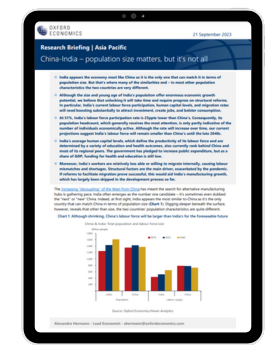China-India: population size matters, but it’s not all

India appears the economy most like China as it is the only one that can match it in terms of population size. But that’s where many of the similarities end – in most other population characteristics the two countries are very different.
This is the first piece in our series of Research Briefings comparing the Chinese and Indian economies. Click here to read the second piece.
What you will learn:
- Although the size and young age of India’s population offer enormous economic growth potential, we believe that unlocking it will take time and require progress on structural reforms.
- At 51%, India’s labour force participation rate is 25ppts lower than China’s. Consequently, its population headcount is only partly indicative of the number of individuals economically active.
- India’s average human capital levels also currently rank behind China and most of its regional peers.
- India’s workers are relatively less able or willing to migrate internally, causing labour mismatches and shortages. If reforms to facilitate migration prove successful, this would aid India’s manufacturing growth.
Tags:
Related Posts

Post
Food prices to bottom out in 2024, risks skewed to upside
Our baseline forecast is for world food commodity prices to register an annual decline this year, in aggregate, reducing pressure on food retail prices further downstream. However, we believe the risks to this forecast are overwhelmingly skewed to the upside.
Find Out More
Post
Indian and Australian cities to outpace rivals over 2024-28
We forecast Indian cities to outpace the rest of APAC in terms of GDP growth over the medium term (2024-28). Southeast Asian cities such as Ho Chi Minh City and Jakarta will come close to matching Indian cities and will outperform Chinese ones. Among advanced APAC cities, we expect that Australian ones will fill the top two positions in terms of medium-run GDP growth.
Find Out More
